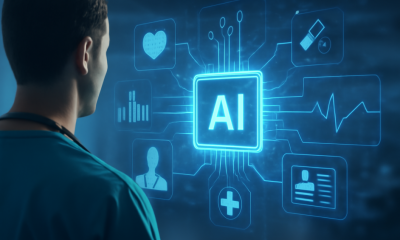Healthcare
How AI Predicted Coronavirus and Can Prevent Future Pandemics – Opinion

BlueDot AI Prediction
On January 6th, the US Centers for Disease Control and Prevention (CDC) notified the public that a flu-like outbreak was propagating in Wuhan City, in the Hubei Province of China. Subsequently, the World Health Organization (WHO) released a similar report on January 9th.
While these responses may seem timely, they were slow when compared to an AI company called BlueDot. BlueDot released a report on December 31st, a full week before the CDC released similar information.
Even more impressive, BlueDot predicted the Zika outbreak in Florida six months before the first case in 2016.
What are some of the datasets that BlueDot analyzes?
- Disease Surveillance, this includes scanning 10,000+ media and public sources in over 60 languages.
- Demographic data from national censuses, and national statistic reports. (Population density is a factor behind virus propagation)
- Real-time climate data from NASA, NOAA, etc. (Viruses spread faster in certain environmental conditions)
- Insect vectors and animal reservoirs (Important when virus can spread from species to species).
BlueDot currently works with various Government agencies including Global Affairs Canada, Public Health Agency of Canada, the Canadian Medical Association, and the Singapore Ministry of Health. The BlueDot Insights product sends near real-time infectious disease alerts. Some advantages behind this product include:
- Reducing the risk of exposure to frontline healthcare workers
- Global visibility enables time saving on infectious disease surveillance
- Opportunity to communicate crucial information clearly before it’s too late.
- Ability to protect populations from infections
How AI Predictability Could Be Improved
What’s preventing the BlueDot AI and similar AIs from improving? The number one limiting factor is inability to access the necessary big data in real-time.
These types of predictive systems rely on big data feeding into an artificial neural network (ANN), which uses deep learning to search for patterns. The more data that is fed into this ANN, the more accurate the machine learning algorithm becomes.
This essentially means that what is preventing the AI from being able to flag a potential outbreak sooner than later, is simply a lack of access to the necessary data. In countries like China which regularly monitor, and filter news, these delays to the necessary data are even more pronounced. The censoring process of each datapoint can significantly reduce the amount of available data, and worse, can even completely remove the accuracy of this data, which removes the potential usefulness of this data. Faulty data was even why previous efforts such as Google Flu Trends failed.
In other words, the major problem that is preventing AI systems from fully being able to predict an outbreak as early as possible is Government interference. Governments like China, and the current Trump administration, need to remove themselves from any type of data filtering, and enable full access to the press to report on global health issues.
That being stated, reporters can only work with the information that is available to them. Bypassing news reports and accessing sources directly would enable machine learning systems to access data in a timelier and more efficient fashion.
What Needs to be Done
Starting immediately, Governments that are truly interested in reducing the cost of healthcare, and preventing an outbreak, should begin a mandatory review of how their health clinics, and hospitals, can distribute certain datapoints in real-time to officials, reporters and AI systems.
Individual private information can be completely stripped from each patient, enabling the patient to remain anonymous while the important data is shared.
A network of hospitals in any city that collects data in real-time and shares this data would be able to offer superior healthcare. For example, it could be tracked that a specific hospital has shown an increase in patients showing flu-like symptoms, with 3 patients at 10:00 AM, to 7 patients at 1:00 PM, to 49 patients by 5:00PM. This data could be compared to hospitals within the same region, for immediate alerts that a certain region is a potential hotzone.
Once this information is collected and assembled, the AI system could trigger alerts to all neighboring regions so that necessary precautions can be made.
While this would be difficult in certain regions of the world, countries with large AI hubs and smaller population densities such as Canada could institute such an advanced system. Canada has AI hubs in the most populated provinces (Waterloo and Toronto, Ontario, and Montreal, Quebec). The advantages of this inter-hospital and inter-provincial cooperation could be extended to offer Canadians other benefits such as accelerated access to emergency medical care, and reduced healthcare spending. Canada could become a leader in both AI and healthcare, licensing this technology to other jurisdictions.
Most importantly, once a country such as Canada has a system in place, the technology/methodologies can then be cloned and exported to other regions. Eventually, the goal would be to blanket the entire world, to ensure outbreaks are a relic of the past.
This type data collection by healthcare workers has benefits for multiple applications. There is no reason why in 2020 that a patient should have to register themselves with each hospital individually, and that those same hospitals are not communicating to one another in real-time. This lack of communication can result in the loss of data with patients who suffer from dementia, or other symptoms which may prevent them from fully communicating the severity of their condition, or even where else they have been treated.
Lessons Learned
We can only hope that governments around the world, take advantage of the important lessons that coronavirus is teaching us. Humanity should consider itself lucky that coronavirus has a relatively mild fatality rate compared to some infectious agents of the past such as the Black Plague which is estimated to have killed 30% to 60% of Europe's population.
The next time we might not be so lucky, what we do know so far, is that governments are currently ill-equipped to deal with the severity of an outbreak.
Bluedot was conceived in the wake of Toronto’s 2003 SARS outbreak and launched in 2013. The goal was to protect people around the world from infectious diseases with human and artificial intelligence. The AI component has demonstrated remarkable ability to predict the path of infectious diseases, what remains is the human component. We need new policies in place in order to enable companies such as BlueDot to excel at what they do best. As people we need to demand more from our politicians, and healthcare providers.












